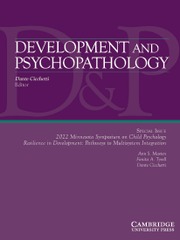No CrossRef data available.
Article contents
The role of environmental sensitivity in post-traumatic stress symptoms in Lebanese children and adolescents
Published online by Cambridge University Press: 22 January 2024
Abstract
Children differ substantially in their sensitivity to the quality of their environment. Some are more sensitive and more likely to develop Post-Traumatic Stress Disorder (PTSD) in response to Childhood Adversities (CAs), but might also benefit more from Positive Home Experiences (PHE). The aim of this study is to investigate the role of Environmental Sensitivity (ES), CAs and PHEs in PTSD development in children and adolescents. Data was collected from N = 2,569 children/adolescents. PTSD symptoms, CAs, PHEs and ES were assessed with self-report measures. We found that higher ES and CAs emerged as risk factors for PTSD development whereas higher levels of PHEs protected against PTSD. ES moderated the effects of CAs (β = 1.08, p < .001) on PTSD symptoms in the total sample. This moderating effect was more pronounced in girls, suggesting that highly sensitive girls with high childhood adversities were more likely to have higher PTSD symptoms than girls with low levels of sensitivity (β = 1.09, p < .001). In conclusion, Environmental Sensitivity played an important role as a risk factor for PTSD and as a moderating factor that accentuated the main effects of childhood adversities, particularly in girls.
- Type
- Regular Article
- Information
- Copyright
- © The Author(s), 2024. Published by Cambridge University Press
Footnotes
Deceased.



